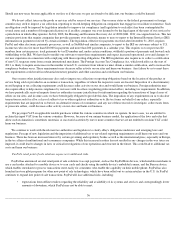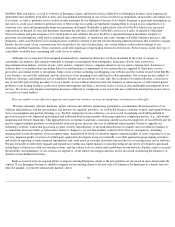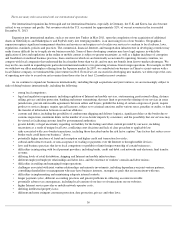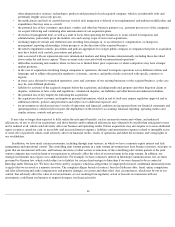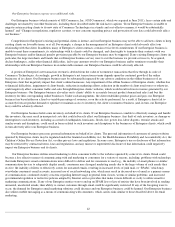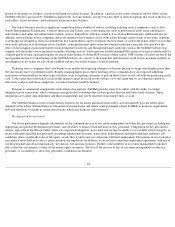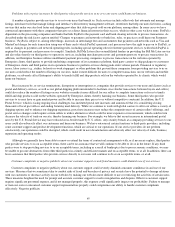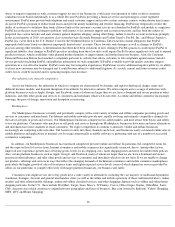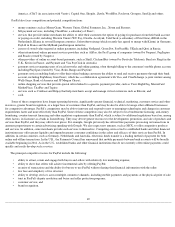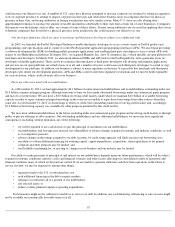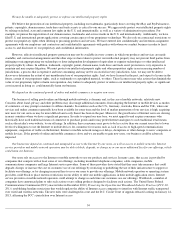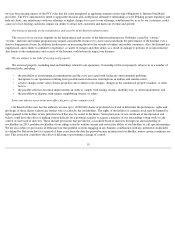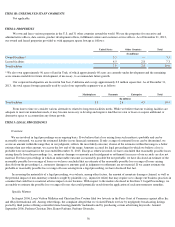eBay 2013 Annual Report Download - page 48
Download and view the complete annual report
Please find page 48 of the 2013 eBay annual report below. You can navigate through the pages in the report by either clicking on the pages listed below, or by using the keyword search tool below to find specific information within the annual report.
about, or negative experiences with, customer support for any of our businesses could cause our reputation to suffer or affect consumer
confidence in our brands individually or as a whole. Because PayPal is providing a financial service and operating in a more regulated
environment, PayPal must provide both telephone and email customer support and resolve certain customer contacts within shorter time frames.
As part of PayPal's program to reduce fraud losses and prevent money laundering and terrorist financing, PayPal may temporarily restrict the
ability of customers to withdraw their funds if those funds or the customer's account activity are identified by PayPal's risk models as suspicious.
PayPal has in the past received negative publicity with respect to its customer support and account restrictions, and has been the subject of
purported class action lawsuits and state attorney general inquiries alleging, among other things, failure to resolve account restrictions promptly.
In the second quarter of 2010, two putative class-action lawsuits (Devinda Fernando and Vadim Tsigel v. PayPal, Inc.; and Moises Zepeda v.
PayPal, Inc.) were filed in the U.S. District Court for the Northern District of California. These lawsuits contain allegations that PayPal
improperly held users' funds or otherwise improperly limited users' accounts. These lawsuits seek damages as well as changes to PayPal's
practices among other remedies. A determination that there have been violations of laws relating to PayPal's practices could expose PayPal to
significant liability. Any changes to PayPal's practices resulting from these lawsuits could require PayPal to incur significant costs and to expend
product resources, which could delay other planned product launches or improvements and further harm our business. Also, the Consumer
Financial Protection Bureau has launched a complaints portal on its website that allows customers to file complaints against money transfer
service providers including PayPal, and publishes information on such complaints. If PayPal is unable to provide quality customer support
operations in a cost-
effective manner, PayPal's users may have negative experiences, PayPal may receive additional negative publicity, its ability
to attract new customers may be damaged and it could become subject to additional litigation. As a result, current and future revenues could
suffer, losses could be incurred and its operating margins may decrease.
Our industries are intensely competitive.
Across our businesses, the industries in which we compete are characterized by dynamic and rapid technological change, many and
different business models, and frequent disruption of incumbents by innovative entrants. We often compete across a range of industries with
platform businesses such as Apple, Google, and Facebook, many of whom are larger than we are, have a dominant and secure position in other
industries, and offer other goods and services to consumers and merchants which we do not offer. As online and offline commerce increasingly
converge, the pace of change, innovation and disruption is increasing.
Marketplaces
Our Marketplaces businesses currently and potentially compete with a wide variety of online and offline companies providing goods and
services to consumers and merchants. The Internet and mobile networks provide new, rapidly evolving and intensely competitive channels for
the sale of all types of goods and services. Our Marketplaces businesses compete in two-sided markets, and must attract both buyers and sellers
to use our platforms. Consumers who purchase or sell goods and services through our Marketplaces businesses have more and more alternatives,
and merchants have more channels to reach consumers. We expect competition to continue to intensify. Online and offline businesses
increasingly are competing with each other. The barriers to entry into these channels can be low, and businesses easily can launch online sites or
mobile platforms and applications at nominal cost by using commercially available software or partnering with any of a number of successful
ecommerce companies.
In addition, our Marketplaces businesses face increased competitive pressure online and offline. In particular, the competitive norm for,
and the expected level of service from, Internet ecommerce and mobile commerce has significantly increased, due to, among other factors,
improved user experience, greater ease of buying goods, lower (or no) shipping costs, faster shipping times and more favorable return policies.
Also, certain platform businesses such as Apple, Google, and Facebook, many of whom are larger than we are, have a dominant and secure
position in other industries, and offer other goods and services to consumers and merchants which we do not offer. If we are unable to change
our products, offerings and services in ways that reflect the changing demands of the Internet ecommerce and mobile commerce marketplaces,
particularly the higher growth of sales of fixed-price items and higher expected service levels (some of which depend on services provided by
sellers on our platforms) or compete effectively with larger platform businesses, our business will suffer.
Consumers who might use our site to buy goods have a wide variety of alternatives, including the vast majority of traditional department,
warehouse, boutique, discount and general merchandise stores (as well as the online and mobile operations of these traditional retailers), online
retailers and their related mobile offerings, online and offline classified services, and other shopping channels such as offline and online home
shopping networks. In the U.S., these include Wal-Mart, Target, Sears, Macy's, JC Penney, Costco, Office Depot, Staples, OfficeMax, Sam's
Club, Amazon.com (which continues to expand into new geographies and lines of business), Buy.com (owned by Rakuten), Yahoo! Shopping,
MSN, QVC and Home Shopping
46


